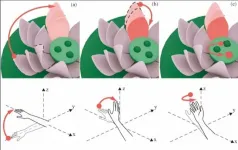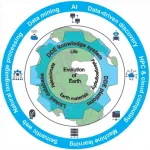(Press-News.org) A new study by Stanford University biologists finds an explanation for the idea that physical characteristics such as skin pigmentation are "only skin deep." Using genetic modeling, the team has found that when two populations with distinct traits combine over generations, traits of individuals within the resulting "admixed" population come to reveal very little about individuals' ancestry. Their findings were published March 27 in a special edition of the American Journal of Physical Anthropology on race and racism.
"When two founding groups first come together, a visible physical trait that differed between those founders initially carries information about the genetic ancestry of admixed individuals," says Jaehee Kim, a postdoctoral research fellow in biology at Stanford and first author of the study. "But this study shows that after enough time has passed, that's no longer true, and you can no longer identify a person's genetic ancestry based only on such traits."
A diminishing correlation
Working with Stanford biology professor Noah Rosenberg and others, Kim built a mathematical model to better understand genetic admixture - the process by which two populations that have long been separated come together and create a third admixed population with ancestral roots in both sources. They specifically studied how the relationship between physical traits and genetic admixture level changes over time.
The researchers considered several scenarios. In one, individuals within the admixed population mated randomly. In others, they were more likely to seek out partners with similar genetic admixture levels or who had similar levels of a trait, in a process known as assortative mating.
The study found that over time, traits that might have initially been indicative of an individual's genetic ancestry ultimately no longer carried that information. While this decoupling of ancestry and traits occurred more slowly if mating was assortative rather than random, decoupling still happened in all scenarios.
"In the model, if assortative mating depends on a genetically inherited trait, a correlation between the trait and genetic ancestry would last longer than if mating had occurred randomly, but the correlation would still disassociate eventually," said Rosenberg, senior author of the paper, who holds the Stanford Professorship in Population Genetics and Society in the School of Humanities and Sciences.
The team's research was inspired in part by a study conducted by a different team in Brazil, a country with much genetic admixture in its history. After sampling individuals and studying their genomes, the biologists from the 2003 study hypothesized that decoupling occurred between physical traits and genetic admixture and claimed that over time traits such as skin pigmentation revealed little about the fraction of a person's ancestors originating from European, African or Native American origins. The Stanford team found that their model largely supported this hypothesis.
Only skin deep
To understand the decoupling, the researchers say, consider a trait such as skin pigmentation that is due in part to variations among a series of genes. If a person happens to receive most of their genetic ancestry from one population but the key genetic variants that determine their skin pigmentation from another, their skin pigmentation may appear to be a "mismatch" to their genetic ancestry. The reshuffling of genetic variants that occurs in every generation increases the probability of such mismatches.
The researchers recognize that there are limitations to their modeling approach. The model didn't consider environmental conditions that also play a role in trait development. A person's height, for example, has some genetic basis, but also depends on factors like nutrition. The model also focused only on scenarios in which the initial admixture happened all at once, and didn't explore the role of new members of the source populations entering the admixed population over time. In the future, Rosenberg plans to add some of these features into the initial model.
According to Kim, the new findings have important implications for understanding the social meaning of physical traits.
"When societies attach social meaning to a trait like skin pigmentation, the model suggests that after admixture has been ongoing for enough time, that trait is not going to be telling us much about genetic ancestry - or about other traits that are based in genetics," she said.
INFORMATION:
Researchers from the University of Southern California and Duke University also contributed to the paper. This research was supported by the National Institutes of Health.
In the fight against cancers, activating mutations in the RAS family of genes stand in the way of finding viable treatment options. Now, scientists at the University of Missouri and Yale University have discovered that one of these mutations -- oncogenic RAS or RASV12 -- is also responsible for the regrowth of cancer cells following genotoxic therapy treatment, or drugs that cause damage to a cancer cell's DNA in order to eliminate it from the body.
"Most of our knowledge of how cells respond to DNA damage is mainly derived from studies looking at the single cell level," said Yves Chabu, an assistant professor in the MU College of Arts and Science. "Therefore, we don't know much about how tumor cells respond to DNA damage in the broader ...
URBANA, Ill. ¬- If your day started with a cup of coffee, there's a good chance your morning brew came from Colombia. Home to some of the finest Arabica beans, the country is the world's third largest coffee producer. Climate change poses new challenges to coffee production in Colombia, as it does to agricultural production anywhere in the world, but a new University of Illinois study shows effects vary widely depending on where the coffee beans grow.
"Colombia is a large country with a very distinct geography. The Andes Mountains cross the country from its southwest to northeast corner. Colombian coffee is currently growing in areas with different altitude levels, and climate impacts will likely be very different for low ...
Pregnancy can increase the risk of morbidity and mortality in women with cardiovascular disease; however, many cardiologists are not having pre-pregnancy contraception discussions with their patients of child-bearing age. There is a need to provide evidence-based guidance for contraceptive safety and effectiveness and pregnancy planning options for this high-risk patient group, according to a paper published in the Journal of the American College of Cardiology (JACC). This paper is one of a five-part JACC focus seminar series addressing a wide range of topics in the emerging cardio-obstetrics field.
Prior research has found that 68% of females have had sex at least once by the time they were 17, ...
A recent study proposed a three-dimensional LotusMenu that can "bloom in the palm". With this menu, even if you are not Nezha, you can also control your own lotus.
The research paper is titled: "LotusMenu: A 3D Menu using Wrist and Elbow Rotation Inspired by Chinese Traditional Symbol". It's published in SCIENCE CHINA Information Sciences recently, written by Associate Professor Lu Fei's human-computer interaction research team from Beijing University of Posts and Telecommunications. Based on the metaphor of the traditional lotus pattern, the researchers ...
The Bureau of Reclamation today released final technical reports supporting the Water Reliability in the West - 2021 SECURE Water Act Report. Reclamation's 2021 West-Wide Climate and Hydrology Assessment and seven individual basin reports provide detailed information on climate change impacts and adaptation strategies to increase water supply reliability in the West. A new 2021 SECURE Report Web Portal is also available to provide a user-friendly, web-based format for delivery of information in the reports.
"Western water supply and delivery systems are affected by changing hydrologic conditions and competing demands," Deputy Commissioner Camille Calimlim Touton said. "These reports highlight Reclamation's effort to use ...
Humans have long explored three big scientific questions: evolution of the universe, evolution of Earth, and evolution of life. Geoscientists have embraced the mission of elucidating the evolution of Earth and life, which are preserved in the information-rich but incomplete geological record that spans more than 4.5 billion years of Earth history. Delving into Earth's deep-time history helps geoscientists decipher mechanisms and rates of Earth's evolution, unravel the rates and mechanisms of climate change, locate natural resources, and envision the future of Earth.
Two common approaches, deductive reasoning ...
Researchers from North Carolina State University have developed an exosome-coated stent with a "smart-release" trigger that could both prevent reopened blood vessels from narrowing and deliver regenerative stem cell-derived therapy to blood-starved, or ischemic, tissue.
Angioplasty - a procedure that opens blocked arteries - often involves placing a metal stent to reinforce arterial walls and prevent them from collapsing once the blockage is removed. However, the stent's placement usually causes some injury to the blood vessel wall, which stimulates smooth muscle cells to proliferate and migrate to the site in an attempt to repair the injury. The result is restenosis: a re-narrowing of the blood vessel previously opened by angioplasty.
"The ...
ITHACA, N.Y. - The cost of harvesting solar energy has dropped so much in recent years that it's giving traditional energy sources a run for their money. However, the challenges of energy storage - which require the capacity to bank an intermittent and seasonally variable supply of solar energy - have kept the technology from being economically competitive.
Cornell University researchers led by Lynden Archer, Dean and Professor of Engineering, have been exploring the use of low-cost materials to create rechargeable batteries that will make energy storage more ...
AMHERST, Mass. - A team of polymer science and engineering researchers at the University of Massachusetts Amherst has demonstrated for the first time that the positions of tiny, flat, solid objects integrated in nanometrically thin membranes - resembling those of biological cells - can be controlled by mechanically varying the elastic forces in the membrane itself. This research milestone is a significant step toward the goal of creating ultrathin flexible materials that self-organize and respond immediately to mechanical force.
The team has discovered that rigid solid plates in biomimetic fluid membranes experience interactions ...
Mouse models of neurodevelopmental disorders possess unique, sex-specific metabolic dysfunctions, according to a new study in eNeuro. Understanding the unique metabolic effects of each disorder in both animal models and humans may lead to more personalized treatments and diagnostic methods.
Any disorder affecting the brain also impacts the body. People with neurodevelopmental disorders -- including Down syndrome and autism spectrum disorders -- are at increased risk for developing diabetes, obesity, and hypertension. Yet the impact of these three disorders on metabolism has not been studied.
Menzies et al. measured the resting energy metabolism of three neurodevelopmental disorder mouse models: Down syndrome, ...







